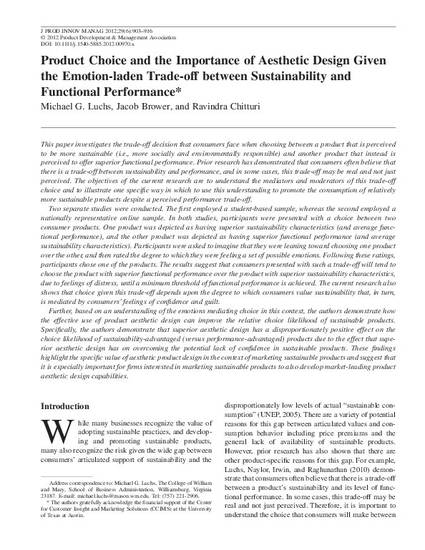
This paper investigates the trade‐off decision that consumers face when choosing between a product that is perceived to be more sustainable (i.e., more socially and environmentally responsible) and another product that instead is perceived to offer superior functional performance. Prior research has demonstrated that consumers often believe that there is a trade‐off between sustainability and performance, and in some cases, this trade‐off may be real and not just perceived. The objectives of the current research are to understand the mediators and moderators of this trade‐off choice and to illustrate one specific way in which to use this understanding to promote the consumption of relatively more sustainable products despite a perceived performance trade‐off.
Two separate studies were conducted. The first employed a student‐based sample, whereas the second employed a nationally representative online sample. In both studies, participants were presented with a choice between two consumer products. One product was depicted as having superior sustainability characteristics (and average functional performance), and the other product was depicted as having superior functional performance (and average sustainability characteristics). Participants were asked to imagine that they were leaning toward choosing one product over the other, and then rated the degree to which they were feeling a set of possible emotions. Following these ratings, participants chose one of the products. The results suggest that consumers presented with such a trade‐off will tend to choose the product with superior functional performance over the product with superior sustainability characteristics, due to feelings of distress, until a minimum threshold of functional performance is achieved. The current research also shows that choice given this trade‐off depends upon the degree to which consumers value sustainability that, in turn, is mediated by consumers’ feelings of confidence and guilt.
Further, based on an understanding of the emotions mediating choice in this context, the authors demonstrate how the effective use of product aesthetic design can improve the relative choice likelihood of sustainable products. Specifically, the authors demonstrate that superior aesthetic design has a disproportionately positive effect on the choice likelihood of sustainability‐advantaged (versus performance‐advantaged) products due to the effect that superior aesthetic design has on overcoming the potential lack of confidence in sustainable products. These findings highlight the specific value of aesthetic product design in the context of marketing sustainable products and suggest that it is especially important for firms interested in marketing sustainable products to also develop market‐leading product aesthetic design capabilities.
